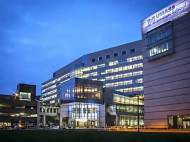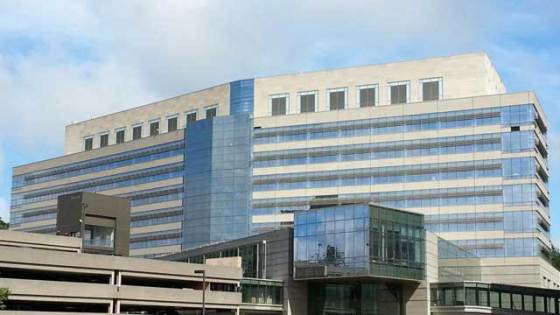UMass Medical School Albert Sherman Center
 University of Massachusetts Worcester campus recently got its greenest academic building which was awarded with LEED Gold certification. Although we can’t say that Albert Sherman Center can be classified among most sustainable architecture projects we previously wrote about, it is still important since it serves as an example how large academic buildings can be built, and it could start a competitive trend by spreading the “sustainability fever” over the campus.
University of Massachusetts Worcester campus recently got its greenest academic building which was awarded with LEED Gold certification. Although we can’t say that Albert Sherman Center can be classified among most sustainable architecture projects we previously wrote about, it is still important since it serves as an example how large academic buildings can be built, and it could start a competitive trend by spreading the “sustainability fever” over the campus.
Designed by Architectural Resources Cambridge, the 11 stories high 47,566-square-meter (512,000-square-foot) facility nearly doubles Worcester campus research capacity and supports the School of Medicine’s new learner-centered curriculum. Albert Sherman Center has nine occupied floors topped by a two-story mechanical systems penthouse. Construction of the Sherman Center and a nearby 1,440-space parking garage was managed by Suffolk Construction. The project cost $400 million, and the team needed 4 years to finish it.
The combination of the building orientation and exterior materials contribute to lower energy consumption. On the north side of the building, where the laboratories are located, the façade is mostly glass, with long windows designed to allow in as much natural light as possible. On the south side of the building, the windows have sun-shades designed to reduce the heat gain and reflect some of the light up to the interior ceilings of the offices and educational spaces. The glass on the south side is also slightly more reflective than the rest of the building to further minimize solar glare and heat gain. The building’s roof is white and gray, and the exterior terracotta lightly colored, so the surfaces reflect rather that absorb heat.
Aside the fact 95 percent of the steel used in the Sherman Center was made from recycled material, they also chose to make it in a steel fabrication plant relatively close to the construction site, thereby reducing the energy consumption and greenhouse gas emissions associated with transportation.
Other sustainable materials and practices used in the Sherman Center include:
- wood finishes harvested from certified sustainable forests
- carpets and textiles made from recycled fibers
- low-flow plumbing fixtures used in most areas.
Compared to similar baseline building, passive and active approaches integrated at the Sherman Center are overall 25 percent more efficient. It includes numerous integrated systems that reduce energy consumption, thereby reducing the building’s carbon footprint. Among those key technologies are:
- occupancy sensors for lighting, heating and cooling of offices and conference rooms
- heat recovery wheels that allow the building to exhaust stale air and draw in fresh air while retaining most of the heat in the building
- variable speed fans, with sash sensors, on the fume hoods in the laboratories
- daylight harvesting sensors that adjust interior lights based on the available sunlight
- Building Automation System (BAS) that monitors building operations every 15 minutes and adjusts systems for greater efficiency.
The building is expected to annually lower electricity consumption by 4.1 million kW, use 30 percent less water, and cut carbon dioxide emissions by 2,041 metric tones (4.5 million pounds) per year. Rainwater from the roof and condensate water from the heating and cooling systems is captured and reused by the campus power plant, saving 2.8 million liters (750,000 gallons) of fresh water each year.










Leave your response!